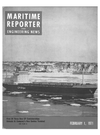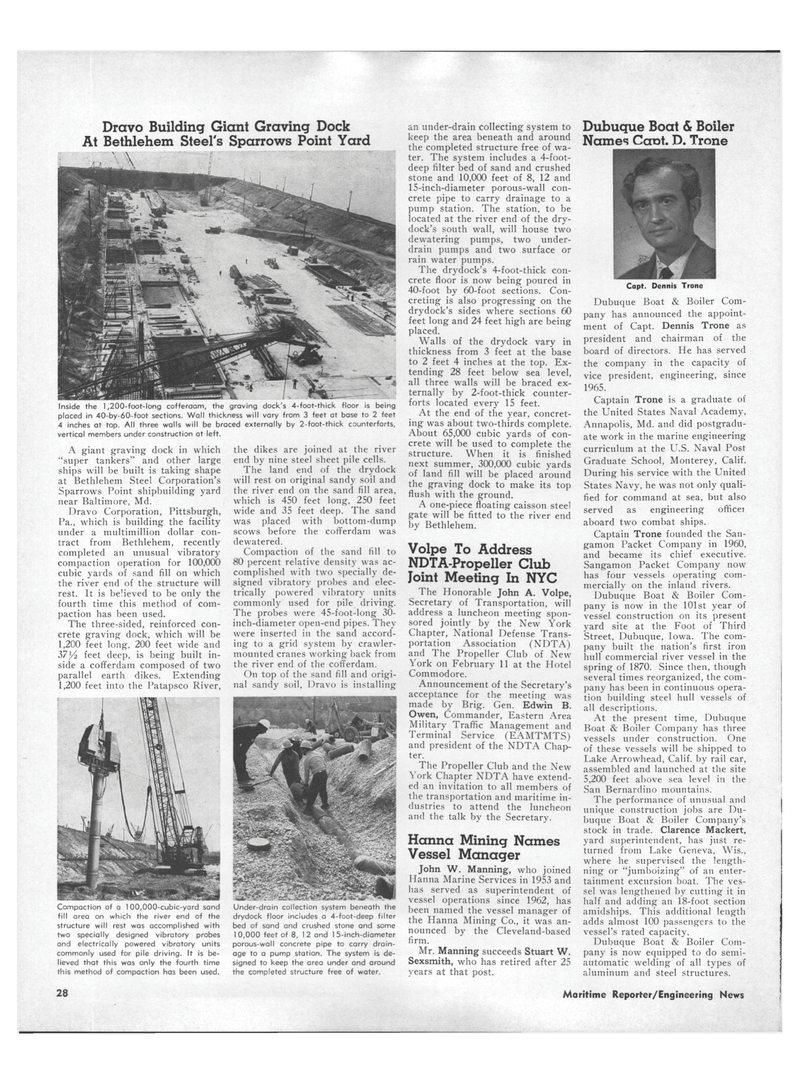
Page 26: of Maritime Reporter Magazine (February 1971)
Read this page in Pdf, Flash or Html5 edition of February 1971 Maritime Reporter Magazine
Dravo Building Giant Graving Dock
At Bethlehem Steel's Sparrows Point Yard
Inside the 1,200-foot-long cofferdam, the graving dock's 4-foot-thick floor is being placed in 40-by-60-foot sections. Wall thickness will vary from 3 feet at base to 2 feet 4 inches at top. All three walls will be braced externally by 2-foot-thick counterforts, vertical members under construction at left.
A giant graving dock in which "super tankers" and other large ships will be built is taking shape at Bethlehem Steel Corporation's
Sparrows Point shipbuilding yard near Baltimore, Md.
Dravo Corporation, Pittsburgh,
Pa., which is building the facility under a multimillion dollar con- tract from Bethlehem, recently completed an unusual vibratory compaction operation for 100,000 cubic yards of sand fill on which the river end of the structure will rest. It is believed to be only the fourth time this method of com- paction has been used.
The three-sided, reinforced con- crete graving dock, which will be 1,200 feet long, 200 feet wide and 37^2 feet deep, is being built in- side a cofferdam composed of two parallel earth dikes. Extending 1,200 feet into the Patapsco River,
Compaction of a 100,000-cubic-yard sand fill area on which the river end of the structure will rest was accomplished with two specially designed vibratory probes and electrically powered vibratory units commonly used for pile driving. It is be- lieved that this was only the fourth time this method of compaction has been used. the dikes are joined at the river end by nine steel sheet pile cells.
The land end of the drydock will rest on original sandy soil and the river end on the sand fill area, which is 450 feet long, 250 feet wide and 35 feet deep. The sand was placed with bottom-dump scows before the cofferdam was dewatered.
Compaction of the sand fill to 80 percent relative density was ac- complished with two specially de- signed vibratory probes and elec- trically powered vibratory units commonly used for pile driving.
The probes were 45-foot-long 30- inch-diameter open-end pipes. They were inserted in the sand accord- ing to a grid system by crawler- mounted cranes working back from the river end of the cofferdam.
On top of the sand fill and origi- nal sandy soil. Dravo is installing
Under-droin collection system beneath the drydock floor includes a 4-foot-deep filter bed of sand and crushed stone and some 10,000 feet of 8, 12 and 1 5-inch-diameter porous-wall concrete pipe to carry drain- age to a pump station. The system is de- signed to keep the area under and around the completed structure free of water. an under-drain collecting system to keep the area beneath and around the completed structure free of wa- ter. The system includes a 4-foot- deep filter bed of sand and crushed stone and 10,000 feet of 8, 12 and 15-inch-diameter porous-wall con- crete pipe to carry drainage to a pump station. The station, to be located at the river end of the dry- dock's south wall, will house two dewatering pumps, two under- drain pumps and two surface or rain water pumps.
The drydock's 4-foot-thick con- crete floor is now being poured in 40-foot by 60-foot sections. Con- creting is also progressing on the drydock's sides where sections 60 feet long and 24 feet high are being placed.
Walls of the drydock vary in thickness from 3 feet at the base to 2 feet 4 inches at the top. Ex- tending 28 feet below sea level, all three walls will be braced ex- ternally by 2-foot-thick counter- forts located every 15 feet.
At the end of the year, concret- ing was about two-thirds complete.
About 65,000 cubic yards of con- crete will be used to complete the structure. When it is finished next summer, 300,000 cubic yards of land fill will be placed around the graving dock to make its top flush with the ground.
A one-piece floating caisson steel gate will be fitted to the river end by Bethlehem.
Volpe To Address
NDTA-Propeller Club
Joint Meeting In NYC
The Honorable John A. Volpe,
Secretary of Transportation, will address a luncheon meeting spon- sored jointly by the New York
Chapter, National Defense Trans- portation Association (NDTA) and The Propeller Club of New
York on February 11 at the Hotel
Commodore.
Announcement of the Secretary's acceptance for the meeting was made by Brig. Gen. Edwin B.
Owen, Commander, Eastern Area
Military Traffic Management and
Terminal Service (EAMTMTS) and president of the NDTA Chap- ter.
The Propeller Club and the New
York Chapter NDTA have extend- ed an invitation to all members of the transportation and maritime in- dustries to attend the luncheon and the talk by the Secretary.
Hanna Mining Names
Vessel Manager
John W. Manning, who joined
Hanna Marine Services in 1953 and has served as superintendent of vessel operations since 1962, has been named the vessel manager of the Hanna Mining Co., it was an- nounced by the Cleveland-based firm.
Mr. Manning succeeds Stuart W.
Sexsmith, who has retired after 25 years at that post.
Dubuque Boat & Boiler
Names Cant. D. Trone
Capt. Dennis Trone
Dubuque Boat & Boiler Com- pany has announced the appoint- ment of Capt. Dennis Trone as president and chairman of the board of directors. He has served the company in the capacity of vice president, engineering, since 1965.
Captain Trone is a graduate of the United States Naval Academy,
Annapolis, Md. and did postgradu- ate work in the marine engineering curriculum at the U.S. Naval Post
Graduate School, Monterey, Calif.
During his service with the United
States Navy, he was not only quali- fied for command at sea, but also served as engineering officei aboard two combat ships.
Captain Trone founded the San- gamon Packet Company in 1960, and became its chief executive.
Sangamon Packet Company now has four vessels operating com- mercially on the inland rivers.
Dubuque Boat & Boiler Com- pany is now in the 101st year of vessel construction on its present yard site at the Foot of Third
Street, Dubuque, Iowa. The com- pany built the nation's first iron hull commercial river vessel in the spring of 1870. Since then, though several times reorganized, the com- pany has been in continuous opera- tion building steel hull vessels of all descriptions.
At the present time, Dubuque
Boat & Boiler Company has three vessels under construction. One of these vessels will be shipped to
Lake Arrowhead, Calif, by rail car, assembled and launched at the site 5,200 feet above sea level in the
San Bernardino mountains.
The performance of unusual and unique construction jobs are Du- buque Boat & Boiler Company's stock in trade. Clarence Mackert, yard superintendent, has just re- turned from Lake Geneva, Wis., where he supervised the length- ning or "jumboizing" of an enter- tainment excursion boat. The ves- sel was lengthened by cutting it in half and adding an 18-foot section amidships. This additional length adds almost 100 passengers to the vessel's rated capacity.
Dubuque Boat & Boiler Com- pany is now equipped to do semi- automatic welding of all types of aluminum and steel structures. 28 Maritime Reporter/Engineering News

 25
25

 27
27
